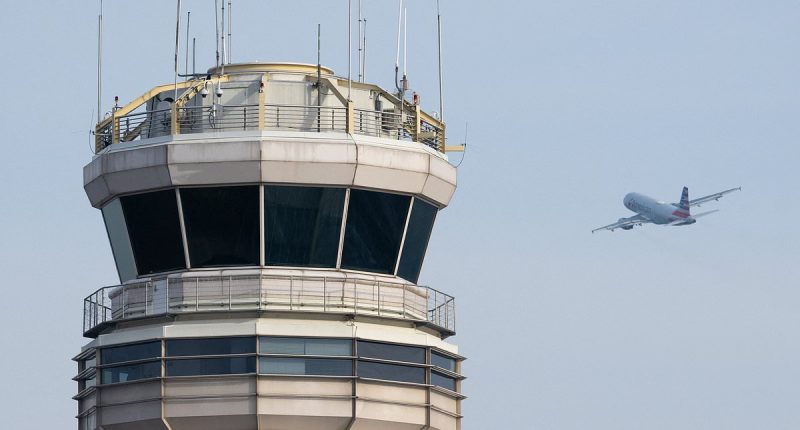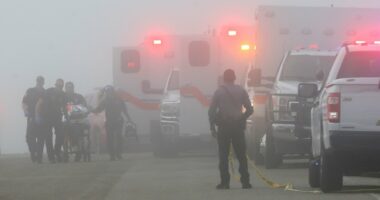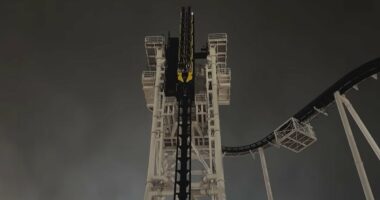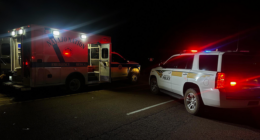Share this @internewscast.com
For 90 seconds on Friday, planes approaching one of the world’s busiest airports were flying blind.
Alarmed air traffic controllers at Philadelphia’s Terminal Radar Approach Control facility (TRACON), tasked with managing aircraft navigation in the airspace, temporarily lost communication with planes traveling to and from Newark Liberty International Airport near New York City.
In an audio recording, a controller is heard informing a FedEx flight that her radar display has gone blank, urging the pilot to press their airline to resolve the persistent technological problems.
In another, the Tower instructs an approaching private jet to stay at or above 3,000 feet in case communication is lost again.
This incident on Friday occurred only days after a similar 30-second outage of both radar and radio – which probably seemed like an eternity for both pilots and controllers – on April 28.
In a recording from that day, a pilot can be heard asking, ‘Approach, are you there?’ on five separate occasions and receiving only dead air in response.
In the Tower, it must have been equally tense. Indeed, multiple air traffic controllers have now taken a 45-day ‘trauma leave’ to cope with the scare.
And yet, the aviation issues have continued in the days since: On Sunday, a 45-minute ground stop was enforced at Newark, further delaying flights, after a problem with audio.
I worked as a traffic controller for 13 years in the Chicago area and experienced my fair share of radio and radar failures. I know firsthand how the immense pressure to keep track of flights and manage these situations feels.

Panic-stricken air traffic controllers momentarily lost telecommunication to aircraft traveling to and from Newark Liberty International Airport just outside of New York City multiple times over the last two weeks.

Luckily, there were capable controllers on duty that day and they were able to respond appropriately, likely by communicating with other facilities in the area to get eyes on the aircraft and guide the pilots to safe landings.

In January, a Black Hawk helicopter collided mid-air with a commercial American Airlines flight near the Ronald Reagan International Airport in Washington, DC, killing 67 people.
In our profession, a bad day in the office means that people may die.
Luckily, there were capable controllers on duty at Philadelphia TRACON during Friday’s radar blackout and they were able to respond appropriately, likely by communicating with other facilities in the area to get eyes on the aircraft and guide the pilots to safe landings.
The safety precautions worked. And aviators and airports must always be prepared for the possibility that their systems will fail.
What I fear, however, is what happens when there aren’t enough competent, experienced controllers in place when things inevitably go wrong the next time.
The truth is America is fast running out of air traffic controllers, and it has been for decades.
According to the National Air Traffic Controllers Association (NATCA) – a union that represents nearly 11,000 certified controllers in the US – 41 percent of its members work 10-hour days, six days a week.
They need to hire an estimated 4,600 more controllers!
This situation cannot continue.
In January, a Black Hawk helicopter collided mid-air with a commercial American Airlines flight near the Ronald Reagan International Airport in Washington, DC, killing 67 people. In the months since, there have been multiple crashes, near-misses and wing clippings on tarmacs.
Yes, US air travel is a significantly safer form of travel than ground transportation, but that doesn’t mean we should ignore the obvious erosion of safety standards.
After the deadly crash in DC, I felt compelled to be a voice for those currently employed as air traffic controllers and unable to speak out themselves.

I was an air traffic controller for 13 years. (Pictured: Todd Yeary).
If America doesn’t get serious about fixing the problems that plague the airline industry, there will only be more unimaginable disasters in our future.
Staffing shortages were an issue the day I was hired in 1989 and the day I resigned in 2002.
The shortfall is a byproduct of the Reagan administration’s decision in 1981 to fire over 11,000 striking air traffic controllers – one of whom was my father.
The workers, who were members of the Professional Air Traffic Controllers Organization (PATCO), had walked off the job in response to failed wage and benefit negotiations with the Federal Aviation Administration.
Reagan labeled the strike illegal and terminated employees who refused to return to work after 48 hours. He then barred them from ever being rehired.
For more than four decades since, the industry has been forced to play catch-up, scrambling to rebuild its workforce without thousands of veteran controllers.
The age requirements of the job present another hurdle to keeping the FAA adequately staffed. In the US, air traffic controllers must retire by the age of 56 and cannot be hired after the age of 31.
Last year, new hires – who are required to attend the sole FAA Academy located in Oklahoma City – barely outpaced the number of workers who retired or otherwise left the field.
If the FAA keeps losing people on their 56th birthday, the attrition will widen the gap of seasoned controllers.
The pandemic, which stalled controller training according to a 2023 audit, only made things worse.
During a press conference Thursday, US Secretary of Transportation Sean Duffy highlighted the years of ‘neglect’ the industry has faced while unveiling a new plan to completely overhaul the air traffic control system in the next three to four years.
This includes building new traffic control centers and replacing hundreds of radars as well as the software, which was previously estimated to cost billions of dollars.

Staffing shortages were an issue the day I was hired in 1989 and the day I resigned in 2002.

During a press conference Thursday, US Secretary of Transportation Sean Duffy highlighted the years of ‘neglect’ the industry has faced while unveiling a new plan to completely overhaul the air traffic control system to be completed in the next three to four years.

During the press conference, Duffy showed equipment currently used by air traffic controllers.

Duffy’s plan includes replacing hardware and software used in air traffic control towers.
Of course, these technological pitfalls have played a part.
Duffy highlighted the antiquated devices used in the air traffic control rooms, some of which are half-a-century old. When machines break down, he claimed, parts are replaced, not by calling the manufacturers, but by shopping on eBay.
In March, NATCA president Nick Daniels, president of the National Air Traffic Controllers Association revealed there are computers running on Windows 95 and archaic floppy disks.
I remember as a kid going to work with my dad at the control center and being able to touch the equipment – and it was that same equipment that I worked on as an adult until it was eventually upgraded in the nineties.
Taken altogether, the industry requires an overhaul that demands vision, leadership and, above all else, funding.
A Trump administration budget proposal includes a $1.2 billion boost for air traffic control and a key House committee has approved $12.5 billion as part of a funding bill.
It’s a start. For these systems will fail again.
If there are seasoned air traffic controllers prepared to respond, tragedies will likely be averted. But that’s a big ‘if.’

















